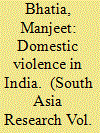| Srl | Item |
| 1 |
ID:
142474


|
|
|
|
|
| Summary/Abstract |
Many inhabitants of Azad Jammu and Kashmir (AJK) hold the belief that their society is not only more egalitarian today than that of their forefathers', but also more egalitarian than that in Pakistan. According to them, Pakistani society continues to be highly hierarchical with stark class and caste-like boundaries, while in AJK these boundaries have become weaker and merely symbolic since the 1970s due to changes in four interconnected factors; namely, migration patterns, land ownership, access to education, and democratic politics. This created an unprecedented level of social mobility among and within biradaris, the caste-like kinship corporate entities that are the crucial social boundary in this region. Yet, the main factor dictating membership in the biradari – endogamy – did not change, and access to power and resources is still determined mostly through biradari-ism. In this paper, I examine how notions of hierarchy and social stratification evolved over time and what contributed to this evolution. I argue and conclude that AJK society is still hierarchical but it has gained an element of fluidity.
|
|
|
|
|
|
|
|
|
|
|
|
|
|
|
|
| 2 |
ID:
113859


|
|
|
|
|
| Publication |
2012.
|
| Summary/Abstract |
After prolonged lobbying, the Protection of Women from Domestic Violence Act of 2005 was implemented in India in October 2006. The Act soon gave rise to cases. This article is based on a preliminary study using questionnaire-based interviews of litigants in Delhi who were involved in cases under the Act. Primary data, taken from all the Delhi Metropolitan Magistrates Courts at that time, concern the background of those who used the law, the litigation process, implementation of the law and the forms of violence addressed. The article seeks to assess the effectiveness of this new legislation and examines specifically what kinds of people bring actions under this new gender-specific law. In addition, qualitative assessment of the perceptions of different kinds of violence by complainants and respondents provides deeper insights into ongoing and potential contestations over gender-based violence.
|
|
|
|
|
|
|
|
|
|
|
|
|
|
|
|